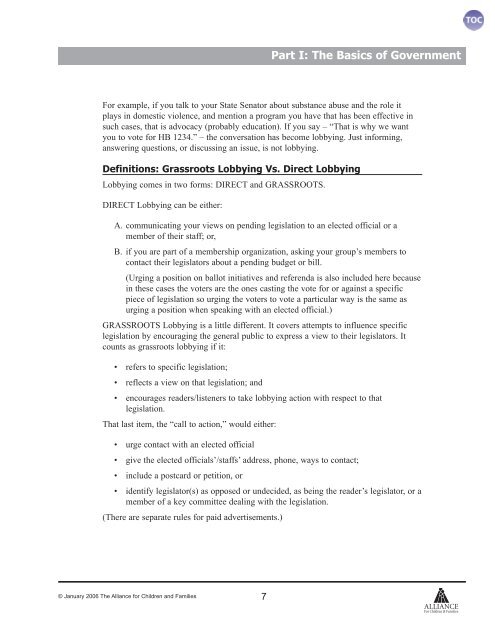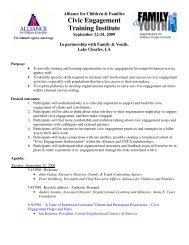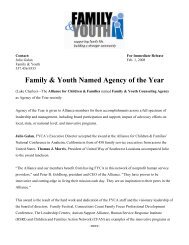Mission-based Advocacy Toolkit from Alliance for Children & Families
Mission-based Advocacy Toolkit from Alliance for Children & Families
Mission-based Advocacy Toolkit from Alliance for Children & Families
Create successful ePaper yourself
Turn your PDF publications into a flip-book with our unique Google optimized e-Paper software.
© January 2006 The <strong>Alliance</strong> <strong>for</strong> <strong>Children</strong> and <strong>Families</strong> 7<br />
Part I: The Basics of Government<br />
For example, if you talk to your State Senator about substance abuse and the role it<br />
plays in domestic violence, and mention a program you have that has been effective in<br />
such cases, that is advocacy (probably education). If you say – “That is why we want<br />
you to vote <strong>for</strong> HB 1234.” – the conversation has become lobbying. Just in<strong>for</strong>ming,<br />
answering questions, or discussing an issue, is not lobbying.<br />
Definitions: Grassroots Lobbying Vs. Direct Lobbying<br />
Lobbying comes in two <strong>for</strong>ms: DIRECT and GRASSROOTS.<br />
DIRECT Lobbying can be either:<br />
A. communicating your views on pending legislation to an elected official or a<br />
member of their staff; or,<br />
B. if you are part of a membership organization, asking your group’s members to<br />
contact their legislators about a pending budget or bill.<br />
(Urging a position on ballot initiatives and referenda is also included here because<br />
in these cases the voters are the ones casting the vote <strong>for</strong> or against a specific<br />
piece of legislation so urging the voters to vote a particular way is the same as<br />
urging a position when speaking with an elected official.)<br />
GRASSROOTS Lobbying is a little different. It covers attempts to influence specific<br />
legislation by encouraging the general public to express a view to their legislators. It<br />
counts as grassroots lobbying if it:<br />
• refers to specific legislation;<br />
• reflects a view on that legislation; and<br />
• encourages readers/listeners to take lobbying action with respect to that<br />
legislation.<br />
That last item, the “call to action,” would either:<br />
• urge contact with an elected official<br />
• give the elected officials’/staffs’ address, phone, ways to contact;<br />
• include a postcard or petition, or<br />
• identify legislator(s) as opposed or undecided, as being the reader’s legislator, or a<br />
member of a key committee dealing with the legislation.<br />
(There are separate rules <strong>for</strong> paid advertisements.)










